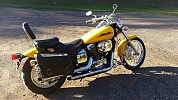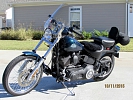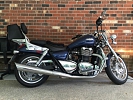Custom CB750. Windjammer III fairing. Mustang seat with sissy bar.
1975 Honda CB
| Price: | US $2,950.00 |
| Item location: | Eau Claire, Wisconsin, United States |
| Make: | Honda |
| Model: | CB |
| SubModel: | CB750 Four Super Sport |
| Type: | Sport Touring |
| Year: | 1975 |
| Mileage: | 8,100 |
| Color: | Orange |
| Engine size: | 750 |
| Vehicle Title: | Clear |
| Contact seller: | Contact form |
This motorcycle was recently taken out of my grandfathers garage after sitting for 20+ years. He always kept it indoors and maintained it properly. When he quit riding. he simply parked it in his garage and it has been forgotten. however the motorcycle was in good working condition when he stored it. The engine kicks over but the battery is dead so it is being sold as-is. It has a Vetter Windjammer III fairing on the front. and I do have the original headlight which is included. The Vetter Windjammer III has a built in radio and speakers. along with a tape player. As far as I know these all work correctly. It also has a custom two up "mustang" seat installed. and I have the original seat as well. The original seat is in good condition. no rips tears etc. and is included. This motorcycle also has a four in one (4-1) exhaust. This motorcycle is in great condition for its age. and is very comfortable. It looks sharp and very vintage. I hope you will enjoy the vintage look of this bike as much as I do. Clean and clear title in hand. as well as a set of keys. A little info about the CB 750 Four Super Sport. what did the F stand for? Fast? Four-into-one? Actually. the F suffix had originated in 1972 with the CB350F—F for four cylinders. so as not to be confused with the CB350K twins. But why did the twins get a K suffix. when the original K appeared on the 1969 CB750 four-banger? Never mind. The year 1975 saw the introduction of three F models. the 400F. the 550F and the 750F. That 400F was truly trick. with mildly set-back footpegs. a flat handlebar and a lovely megaphone-styled exhaust. However. the company decided to go the conservative route with the 750. apparently more concerned with bringing four-piper types into the sporting world than with luring crossover owners from the Ducati realm. This is partially a retelling of the making of the most significant motorcycle of the last 50 years. but it is a story worth hearing again. There was nothing new about disc brakes. electric starters and overhead camshaft. transverse-mounted. four-cylinder engines in 1969—just that Soichiro Honda had made them cheap and reliable. The CB750K was a winner from when it left the starting gate. but everybody knew that winners get old. Which is when the styling artists got their orders. The K was OK. and would remain the mainstay of the lineup. but something snappier needed to be on the showroom floor. Not too snappy. mind you. not like a Laverda 750SF nor an MV Agusta 750S. but something to provide at least the image of snappiness. Call down to the muffler department and tell them to make a four-into-one exhaust system. Have the sheet-metal guys stretch that gas tank out a little. not much. just a smidge to give it a slightly elongated. racy appearance; and hide the gas cap. Then tell the seat people to make a little fiberglass extension to fit the back of the saddle. sort of a faux bum-stop that some single-seaters had. The fast look was born. Of course the frame and engine departments were given their chores. The chassis mathematicians figured that Super Sport riders would go a little faster than those on the standard K. so they gave the fork an extra degree of rake. to 28 degrees. Along with 3?4-inch more trail. And left those ugly gaiters off. Built a slightly longer swingarm. which added up to a 57. 9-inch wheelbase. 6?10-inch longer than on the K. This meant that when the F rider was trickling along U. S. 2 in North Dakota at a modest 100 mph. the bike was reasonably steady. Power was another matter. Honda did not necessarily like to advertise horsepower ratings. but dynamometers don’t lie—unless they are hopelessly miscalibrated. in which case it is not lying. The F put out a good 10 percent more ponies than the K. and while some of those 58 horsepower. at 8. 00 rpm. could be attributed to the freer flowing qualities of the four-into-one exhaust. the rest came from a slight boost in compression ratio. using domed pistons. up from 9:1 to 9. 2:1. And the timing specs on the valves had been altered to adjust to the new exhaust. Also the carburetion was cleaned up a tad. in those halcyon days before the EPA. with the best of intentions. made a botch of things. The F. with a full 4. 8 gallons of high test in the tank. registered slightly over 535 pounds on the scale. Which was 10 pounds heavier than a K. although the F had three less mufflers. Possibly a little extra metal had been included in order to strengthen the double-cradle frame. with triple tubes. a main and two auxiliaries. running under the tank. Put the leg over the saddle. and the rider sat pretty high at 32 inches. Pull the choke on those four 28mm Keihins. turn the key. and choose between pushing the button or kicking the starter; 999 times out of a thousand. the button won. Vrooom! The muffler had a mellow. unobtrusive sound. the engine warmed quickly. and the rider was away. Twenty miles down the road. the Bridgestone Super Speeds were heated appropriately. and the twisties began. Tire technology was still pretty basic 40 years ago. but the 18-inch rear and 19-inch front spoked wheels each had a disc. Hit that first sharp left hander at a rapid speed. and the F felt really good. However. coming back at the same speed. the corner now a right hander. there would be a Grounch! as the collector box located beneath the right footpeg touched down. A little help could be had by getting out the toolkit and maximizing the preload on the shocks. but even then. a 200-pound rider was going to mar the chrome. The owner of this CB750F has changed the shocks to S&W. a distinct improvement. On Apr-22-15 at 07:00:00 PDT. seller added the following information:This motorcycle was recently taken out of my grandfathers garage after sitting for 20+ years. He always kept it indoors and maintained it properly. When he quit riding. he simply parked it in his garage and it has been forgotten. however the motorcycle was in good working condition when he stored it. The engine kicks over but the battery is dead so it is being sold as-is. It has a Vetter Windjammer III fairing on the front. and I do have the original headlight which is included. The Vetter Windjammer III has a built in radio and speakers. along with a tape player. As far as I know these all work correctly. It also has a custom two up "mustang" seat installed. and I have the original seat as well. The original seat is in good condition. no rips tears etc. and is included. This motorcycle also has a four in one (4-1) exhaust. This motorcycle is in great condition for its age. and is very comfortable. It looks sharp and very vintage. I hope you will enjoy the vintage look of this bike as much as I do. Clean and clear title in hand. as well as a set of keys. A little info about the CB 750 Four Super Sport. what did the F stand for? Fast? Four-into-one? Actually. the F suffix had originated in 1972 with the CB350F—F for four cylinders. so as not to be confused with the CB350K twins. But why did the twins get a K suffix. when the original K appeared on the 1969 CB750 four-banger? Never mind. The year 1975 saw the introduction of three F models. the 400F. the 550F and the 750F. That 400F was truly trick. with mildly set-back footpegs. a flat handlebar and a lovely megaphone-styled exhaust. However. the company decided to go the conservative route with the 750. apparently more concerned with bringing four-piper types into the sporting world than with luring crossover owners from the Ducati realm. This is partially a retelling of the making of the most significant motorcycle of the last 50 years. but it is a story worth hearing again. There was nothing new about disc brakes. electric starters and overhead camshaft. transverse-mounted. four-cylinder engines in 1969—just that Soichiro Honda had made them cheap and reliable. The CB750K was a winner from when it left the starting gate. but everybody knew that winners get old. Which is when the styling artists got their orders. The K was OK. and would remain the mainstay of the lineup. but something snappier needed to be on the showroom floor. Not too snappy. mind you. not like a Laverda 750SF nor an MV Agusta 750S. but something to provide at least the image of snappiness. Call down to the muffler department and tell them to make a four-into-one exhaust system. Have the sheet-metal guys stretch that gas tank out a little. not much. just a smidge to give it a slightly elongated. racy appearance; and hide the gas cap. Then tell the seat people to make a little fiberglass extension to fit the back of the saddle. sort of a faux bum-stop that some single-seaters had. The fast look was born. Of course the frame and engine departments were given their chores. The chassis mathematicians figured that Super Sport riders would go a little faster than those on the standard K. so they gave the fork an extra degree of rake. to 28 degrees. Along with 3?4-inch more trail. And left those ugly gaiters off. Built a slightly longer swingarm. which added up to a 57. 9-inch wheelbase. 6?10-inch longer than on the K. This meant that when the F rider was trickling along U. S. 2 in North Dakota at a modest 100 mph. the bike was reasonably steady. Power was another matter. Honda did not necessarily like to advertise horsepower ratings. but dynamometers don’t lie—unless they are hopelessly miscalibrated. in which case it is not lying. The F put out a good 10 percent more ponies than the K. and while some of those 58 horsepower. at 8. 00 rpm. could be attributed to the freer flowing qualities of the four-into-one exhaust. the rest came from a slight boost in compression ratio. using domed pistons. up from 9:1 to 9. 2:1. And the timing specs on the valves had been altered to adjust to the new exhaust. Also the carburetion was cleaned up a tad. in those halcyon days before the EPA. with the best of intentions. made a botch of things. The F. with a full 4. 8 gallons of high test in the tank. registered slightly over 535 pounds on the scale. Which was 10 pounds heavier than a K. although the F had three less mufflers. Possibly a little extra metal had been included in order to strengthen the double-cradle frame. with triple tubes. a main and two auxiliaries. running under the tank. Put the leg over the saddle. and the rider sat pretty high at 32 inches. Pull the choke on those four 28mm Keihins. turn the key. and choose between pushing the button or kicking the starter; 999 times out of a thousand. the button won. Vrooom! The muffler had a mellow. unobtrusive sound. the engine warmed quickly. and the rider was away. Twenty miles down the road. the Bridgestone Super Speeds were heated appropriately. and the twisties began. Tire technology was still pretty basic 40 years ago. but the 18-inch rear and 19-inch front spoked wheels each had a disc. Hit that first sharp left hander at a rapid speed. and the F felt really good. However. coming back at the same speed. the corner now a right hander. there would be a Grounch! as the collector box located beneath the right footpeg touched down. A little help could be had by getting out the toolkit and maximizing the preload on the shocks. but even then. a 200-pound rider was going to mar the chrome. The owner of this CB750F has changed the shocks to S&W. a distinct improvement. ---Rider Magazine
Also published at eBay.com




